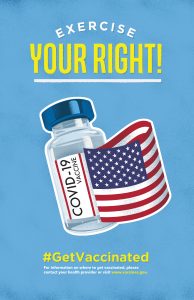
From the February 2022 Desktop News | The University of Alabama Department of Art and Art History recently received a grant to create innovative and accurate poster designs that will harness the power of the arts to engage audiences of all ages in overcoming COVID-19 and influenza vaccine hesitancy. With support from the CDC Foundation, the messaging will promote vaccine education and acceptance in four rural Black Belt counties in west Alabama.
Jason Guynes, department chair and professor, and Dr. Tricia McElroy, dean of fine arts and humanities, first heard about the grant through UA’s partnership with the Alliance for the Arts in Research Universities (a2ru). For Guynes, inspiration arose almost immediately: posters from 1940s.
“The first thing I thought about when I heard about this grant was the old-fashioned poster campaigns,” Guynes said. “Jonathan Cumberland, who is on faculty here, is an internationally-recognized graphic designer and poster designer. It would be a perfect opportunity to get Jonathan involved. And he would produce posters in the same way that a poster campaign went out during World War II for the war effort. And from there, it expanded.”
Cumberland’s posters have been showcased all over the world, and have been cited by Scholastic Publications as an example of outstanding poster design in the United States. To Guynes, enlisting Cumberland’s help was a must.
Although they knew where to start from an artistic standpoint, they needed assistance crafting the message of the posters. Because of this, they enlisted the help of Dr. Martha Crowther, associate dean of research and health policy, and Dr. Hee Yun Lee, associate dean for research and endowed academic chair for the School of Social Work for assistance.
“They’re very familiar with these areas,” McElroy said. “They have established networks with healthcare workers and pastoral leaders, among others. These are really tight-knit communities—they’re faith-based and intergenerational, so it helped us think about how we might pitch the message, how to target these communities in particular.”
Through this collaboration, the group was able to develop messaging to reach communities in Greene, Hale, Marengo, and Sumter counties, where the vaccination rates are among the lowest in the nation. All five designs will target a variety of groups within these counties, and be displayed on billboards, posters, and sandwich boards in health centers, businesses, and other communal institutions.
“We are very excited for the CDC Foundation’s support on this project,” said Dr. Joseph Messina, dean of the College of Arts and Sciences. “The opportunity to make a difference in our own communities is one of the best parts of working at an institution like UA. My hope is that, with this grant, we’re able to make a real change, and help our neighbors by improving vaccine confidence.”
The CDC Foundation helps the Centers for Disease Control and Prevention (CDC) save and improve lives by unleashing the power of collaboration between CDC, philanthropies, corporations, organizations and individuals to protect the health, safety and security of America and the world. Since January 2020, the CDC Foundation, through the support of its donors, has addressed a wide variety of critical needs during the COVID-19 pandemic. This work has included providing personal protective equipment for frontline responders; care kits for schools, jails and the unhoused; studies examining the impact of COVID-19; work to strengthen communities and community-based organizations to improve vaccination uptake and address misinformation; more than 100 projects focused on health equity; and much more.
“We are excited to bring the arts and science together in a really powerful way with these partnerships,” said Judy Monroe, MD, president and CEO of the CDC Foundation. “Through their chosen art forms, these organizations will be able to create accessible and inspiring work that communicates essential health information about the safety and importance of vaccination in protecting communities from COVID-19 and influenza.”
Funding for this effort is made possible through a subaward from the CDC Foundation and is part of a Centers for Disease Control and Prevention (CDC) of the U.S. Department of Health and Human Services (HHS) financial assistance award totaling $2,500,000.00 with 100 percent funding from CDC/HHS. The contents are those of the author(s) and do not necessarily represent the official views of, nor an endorsement by, CDC/HHS or the U.S. Government.